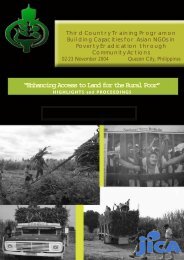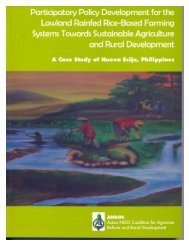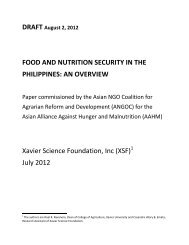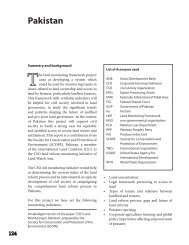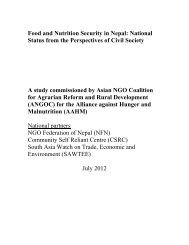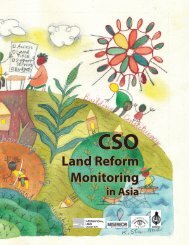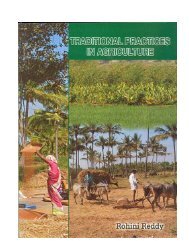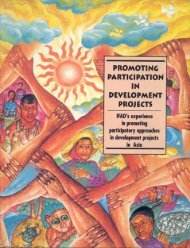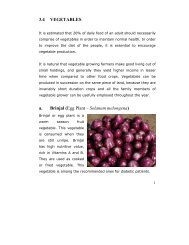Securing the Right to Land FULL - ANGOC
Securing the Right to Land FULL - ANGOC
Securing the Right to Land FULL - ANGOC
Create successful ePaper yourself
Turn your PDF publications into a flip-book with our unique Google optimized e-Paper software.
ever, <strong>the</strong> Government has initiated <strong>the</strong> process of converting<br />
most Guthi in<strong>to</strong> Raika land.<br />
Before <strong>the</strong> 1950s, <strong>the</strong> country’s cultivable land was divided as<br />
follows:<br />
Raikar 963,500 hectares<br />
Birta 700,080 hectares<br />
Guthi 40,000 hectares<br />
Kipat 77,090 hectares<br />
Rajya, Jagir, Rakam and o<strong>the</strong>rs 146,3336 hectares<br />
(Evaluation of land reform in Nepal—1973, M.A. Zaman FAO)<br />
While Guthi and Raikar tenure systems are <strong>the</strong> only officially<br />
recorded systems in Nepal, an informal land tenure system exists<br />
alongside <strong>the</strong>se. This type of land tenure system is mostly<br />
found in urban and semi-urban areas of Nepal, but it has also<br />
been observed in remote areas. Government and public lands<br />
are occupied by landless people, conflict victims, bonded laborers<br />
and rebel groups. (Paudel, 2006).<br />
Dual Ownership of <strong>Land</strong><br />
The tenancy based tenure system is <strong>the</strong> kind which gives rise <strong>to</strong><br />
“dual ownership,” as both land owner and holder (tenant) exer-<br />
cise control over <strong>the</strong> land.<br />
Dual ownership tends <strong>to</strong> discourage long-term agricultural investments<br />
because of <strong>the</strong> insecurity of tenancy and <strong>the</strong> unequal<br />
apportionment of benefits. Moreover, due <strong>to</strong> fear of eviction, <strong>the</strong><br />
tenant is often forced <strong>to</strong> accept onerous rental conditions of <strong>the</strong><br />
landowner, leading <strong>to</strong> severe exploitation in certain cases.<br />
Dual ownership of land was abolished by <strong>the</strong> fourth amendment<br />
(1996) of <strong>the</strong> 1964 <strong>Land</strong> Act. However, about 13% of farm<br />
holders are still operating under rented tenure arrangements on<br />
about 8.7% of <strong>the</strong> country’s land. This means that as much as<br />
13% of landholdings and 8.7% of all farmlands still remain under<br />
dual ownership. Of lands operating under rented tenure arrangements,<br />
about 6% are run under <strong>the</strong> “share of produce”<br />
rental arrangement. Given that landowners are not inclined <strong>to</strong><br />
report this kind of arrangement, and tenants fear reprisals from<br />
<strong>the</strong>ir landlord, <strong>the</strong> incidence of dual ownership of land is likely<br />
<strong>to</strong> be far higher than has been officially reported.<br />
The process of putting an end <strong>to</strong> dual ownership is also hampered<br />
by <strong>the</strong> fact that 85% of tenants are unable <strong>to</strong> present <strong>the</strong> docu-<br />
ASSERTING FREEDOM FROM CENTRAL CONTROL<br />
113<br />
ments necessary <strong>to</strong> establish <strong>the</strong>ir rights <strong>to</strong> <strong>the</strong> land: (1) <strong>the</strong><br />
contract with <strong>the</strong> landlord; and (2) a receipt of grain payment.<br />
Insecurity of <strong>Land</strong> Tenure<br />
To be considered a tenant, a farmer must have tilled or worked<br />
on ano<strong>the</strong>r person’s land for livelihood for at least two crops in a<br />
row. Tenancy rights conferred ownership rights on half of <strong>the</strong><br />
land being tilled.<br />
In 1964, when <strong>the</strong> government formulated <strong>the</strong> first <strong>Land</strong> Act<br />
and in so doing established tenancy rights, 1,818,975 tillers<br />
applied for tenancy rights; of this number, 1,546,734 got provisional<br />
certificates. However, only 318,596 of <strong>the</strong>se were actually<br />
registered as tenants. Ano<strong>the</strong>r round of registration was<br />
called pursuant <strong>to</strong> <strong>the</strong> fourth amendment of <strong>the</strong> <strong>Land</strong> Act, promulgated<br />
in 1996, and those who did not register had <strong>the</strong>ir tenancy<br />
rights cancelled. Because many of <strong>the</strong> tenants were<br />
illiterate and unaware of this law, as many as 560,000 of <strong>the</strong>m<br />
failed <strong>to</strong> register, and lost <strong>the</strong>ir tenancy rights in <strong>the</strong> process.<br />
Today, more than 40% of peasants have no tenancy rights.<br />
Even those with tenancy rights are not that secure of <strong>the</strong>ir land<br />
tenure. At least one tenant is evicted by a landlord in Nepal every<br />
day (CSRC, 2005). The <strong>Land</strong> Act 1964 has given <strong>the</strong> landlord<br />
all sorts of excuses <strong>to</strong> do this.<br />
Feudal and Exploitative Practices: Haliya/<br />
Haruwa<br />
Literally, Haliya/Haruwa is a male who ploughs his master’s field<br />
for very low wages. Such a ploughman is called Haliya in <strong>the</strong><br />
hills, and Haruwa in <strong>the</strong> plains. Haliya/Haruwa also refers <strong>to</strong> a<br />
kind of bonded labor—debt bondage in particular. The Haliya/<br />
Haruwa ploughs <strong>the</strong> landlord’s farm on an annual contract, but<br />
since he cannot make enough money <strong>to</strong> pay off <strong>the</strong> principal,<br />
he tills <strong>the</strong> land <strong>to</strong> pay off <strong>the</strong> interest. Since he is not free <strong>to</strong> do<br />
work for anyone else, he has little chance of earning enough <strong>to</strong><br />
repay his loan. Since it is in <strong>the</strong> interest of <strong>the</strong> landlord <strong>to</strong> keep<br />
<strong>the</strong> Haliya/Haruwa in his debt, he plays all sorts of tricks, such<br />
as making <strong>the</strong> Haliya/Haruwa sign for a loan much more than<br />
what he actually received (e.g. having <strong>the</strong> Haliya/Haruwa sign<br />
for a 5,000 rupee loan, <strong>the</strong>n surreptitiously adding ano<strong>the</strong>r “0”<br />
<strong>to</strong> <strong>the</strong> amount in <strong>the</strong> signed document). Even when Haliyas go<br />
<strong>to</strong> pay back <strong>the</strong> principal, <strong>the</strong> landlord makes up one excuse or<br />
ano<strong>the</strong>r not <strong>to</strong> accept it. And when <strong>the</strong> loan interest is compounded<br />
from year <strong>to</strong> year, <strong>the</strong> whole family is bound <strong>to</strong> repay<br />
<strong>the</strong> loan.<br />
ASIAN NGO COALITION FOR AGRARIAN REFORM AND RURAL DEVELOPMENT



